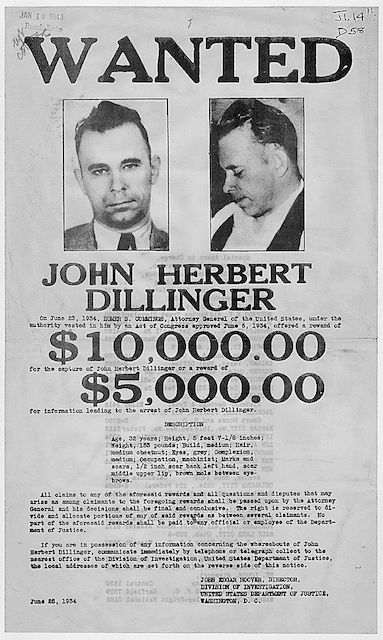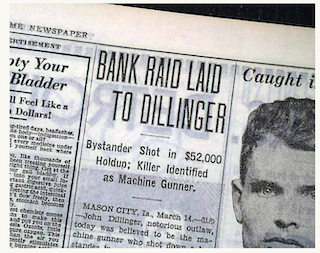
This wanted poster of John Dillinger was issued by the Federal Bureau of Investigation (FBI) on June 25, 1934, during the FBI’s nationwide manhunt for the gangster. The poster advertised a reward of $10,000 for the capture of Dillinger, or $5,000 for information leading to his arrest. FBI Director Edgar J. Hoover made Dillinger’s capture the FBI’s top priority. Less less than one month after this poster was circulated, Dillinger was shot and killed by law enforcement officials in Chicago, Ill. Photo courtesy of the Publications of the U.S. Government
Jan/Feb 2024 (Volume 16, Issue 1)
By Michael Swanger
With the tail-end of winter hanging in the air the buttoned-up residents of Mason City went about their daily routines on the afternoon of March 13, 1934, as though it were just another Tuesday. Little did they know that their tranquility was about to be shattered by the audacious actions of the most famous bank robber in U.S. history — John Dillinger — or that the crime that his gang would commit would be etched into the fabric of the town’s history.
Minutes must have felt like an eternity to the unsuspecting 31 employees and approximately 25 customers inside Mason City’s First National Bank when the Dillinger Gang — Dillinger, George “Baby Face” Nelson, Eddie Green, Homer Van Meter, John Hamilton and Tommy Carroll — armed with Thompson submachine guns swiftly entered the bank. The gang secured the lobby by shouting orders to the staff and shooting into the ceilings and walls before stealing approximately $52,000 in cash (worth about $1 million today) from the vault. A tear gas cartridge was fired by the bank’s security guard Tom Walters positioned above the lobby in a bulletproof enclosure to thwart the heist, striking Green in the back. A volley of bullets was returned by Green, who had grabbed bank executive R.L. Stephenson to use as a shield, shattering the booth but missing Walters. Miraculously, no one was fatality wounded during the robbery.
Outside, freelance filmmaker H.C. Kunkleman was shooting footage of the bank when one of the gang’s six members told him to stop filming (though he would capture five minutes of footage of the gang’s escape). A crowd of bystanders had quickly gathered in front of the bank after a local motorist notified police. Minutes later the gangsters exited First National Bank and jumped into their luxury getaway car, a 1933 Buick 90. The heist contributed to Dillinger’s purse of more than $300,000 that he would net during his Depression-era crime spree.

The Dillinger Gang robbed $52,000 from the First National Bank in Mason City on March 13, 1934, which made newspaper headlines the following day.
Despite taking on fire from the ground and a window above, the Dillinger Gang escaped with minor wounds only to Dillinger and Hamilton. In return, they wounded two bystanders, and took approximately 11 hostages according to newspaper reports. About three miles southeast of Mason City, the Dillinger Gang released the last of their hostages who were forced at gunpoint to stand on the Buick’s running boards as they sped away from the scene of the crime before making their way across the Iowa-Minnesota border to a safe haven in St. Paul.
The Mason City bank robbery, one of a dozen that Dillinger committed in the Midwest from June 1933 to June 1934, made national headlines in newspapers the next day. Reports of the brazen crime committed during broad daylight in the serene northern Iowa town and the gang’s subsequent escape captivated the imagination of readers across the nation and the ire of federal and state law enforcement officials.
On one hand, Dillinger’s criminal exploits were seen as a symbol of rebellion against the banks and U.S. government which many citizens blamed for the Great Depression. Among a segment of the population during the Depression, Dillinger enjoyed a folk-hero status, though he was far from being a modern day Robin Hood as the media portrayed him. Instead of giving money to the poor, Dillinger spent his stolen loot on lavish clothes, cars and prostitutes. Still, many viewed him as a “happy villain,” like Jesse James.
On the other hand, the Dillinger Gang’s reign of terror throughout the Midwest would include killing 10 men and wounding seven others while robbing banks and police arsenals, and staging three jail breaks, according to federal records. (Dillinger was charged with but not convicted of the murder of a police officer in East Chicago, Ind.). It also inspired J. Edgar Hoover and other federal law enforcement officials to retool and rename the Bureau of Investigation into the more sophisticated and effective Federal Bureau of Investigation (FBI) in their relentless pursuit of Dillinger and crackdown on organized crime. Hoover made Dillinger’s capture the FBI’s top priority, naming him the nation’s first “Public Enemy No. 1” in June 1934 and offering rewards of $10,000 for his capture and $5,000 for information leading to his arrest.
Ultimately, Dillinger’s criminal career would end violently when he was gunned down by law enforcement agents outside the Biograph Theater in Chicago, Ill., on July 22, 1934. He was only 31 years old. According to the FBI, the madam of a Chicago brothel, Ana Cumpanas, whose stage name was Anna Sage, tipped off the feds that she would accompany Dillinger and his girlfriend to the theater that night.
Ninety-years after Dillinger’s robbery of the First National Bank in Mason City, townsfolk still talk about the notorious gangster and his crime committed in their hometown on March 13, 1934, with a mix of nostalgia and disdain. Over the years, Mason City has hosted a reenactment of the bank robbery and artifacts from the robbery are stored at the Mason City Public Library. Today a plaque affixed to the building that once housed the bank that Dillinger robbed, and is now known as the City Center/Kent Apartments, marks the spot where Dillinger left an indelible impression on Mason City.
TO READ THE ENTIRE STORY AND OTHER FASCINATING STORIES ABOUT IOWA HISTORY, subscribe to Iowa History Journal.
